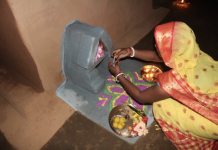To escape the monotony of the city, one seeks a different rhythm to life. Visiting monuments is one such escapade, I believe. They are a gateway to history, politics and culture of a bygone era, in which the life had manifested in different meanings.
The monuments contain a plethora of secrets: who built the monument, why was it built, who were the artisans, what the architecture is, what the political system was and why it needed. Visiting monuments can therefore be an educative experience. The grandeur of monuments evokes a sense of dream and amazement. They are one of the few public places left which allow people to explore history, politics and culture.
Since monuments are a revisit into history, they can nudge our minds to prod deeper into the bygone era, to feel the pulse of the city then. The stories of a tour guide can, in fact, breathe life into these large structures that have survived the onslaught of ‘time.’
These structures of historic and civilizational significance have faced the onslaught of invaders and the hatred of many rulers. People have also tried to make them symbols of their identity which has ultimately landed these innocent, speechless structures into many disputes. But have we ever tried to use their space for critical engagement? It is a lack of imagination and creativity that they have been left aside from the present day stories of smart cities and development. Still, they hold a treasure of records, tales, enigma and reticent spectators and listeners of the voices of the visitors.
Amitav Ghosh (2015) explores the inability of humankind to respond with urgency to the imminent danger posed by climate change. He argues that imagination within literature has experienced limitations and gotten accustomed to a defined path.
He traces this phenomenon to 19th century literature which emphasised the ‘regularity of bourgeois life’. The style of writing underwent a change in which what was out there and its description was emphasised; ‘uncanny’ incidents were treated as exceptions and their probability of occurrence negligible.
Such a thought process, Ghosh argues, has ‘regulated’ ideas and thought processes to such an extent that the ‘bourgeois belief in regularity of the world’ has pushed us to a ‘point of derangement’. The malls, IT parks, highways, metros- which make the city a concrete jungle, are increasingly being considered as the norm for the development of a city. The ‘regularity’ that has pervaded in the conception of the city considers it only as an economic unit, not a place which has a history, culture, nature and politics.
To create something mammoth and grand has always been an intrinsic desire of mankind. It is perhaps a result of the wish of mortals to leave behind their imprints. But what is the story of its creation is of significance to know. The big structures of today are magnificent in terms of their sheer size, but to visit them is a drastically different experience than visiting a monument.
These big structures represent the dreams we are being forced to imagine. To be able to work in an IT firm and earn enough money to shop in a mall and buy a car that rides smoothly on the highway that connects us to our house in a luxury housing society-the ultimate dream that we must strive for.
They represent unsustainable ideas that pervade our culture of living, remove us from practices and ideas that are sustainable in nature and create tombs out of a city which asphyxiates its people and Nature.
The cities are increasingly being thought of along these lines. The politics of urban planning does not consider the history of a city; it tramples on it with a mindless zeal. These big structures arrange life in a manner which is linear and leaves little scope to think what exists beyond the immediate- they create monoliths out of cities.
The Cyber City of Gurgaon and the Golf Course Road to name a few, with its luxury housing societies seems like the pinnacle of development. But Gurgaon too with its polluted air, loss of green cover and exploitation of the Aravalis sits on unsustainable ideas and imagination. It is an imagination which is in stark contrast to that of the monuments, whose architecture and engineering blended with Nature and its cycle.
History is also resistant, hard to forget or be erased as is evident by the symbols of our past. In Delhi itself, there are multiple monuments, a tiny universe within themselves which give Delhi an ‘old soul’ character. This stands in contrast to Gurgaon, a city which seeks to modernize in a myopic sense, trampling over old world charm of its war memorials, library, and history of the names of streets and roads.
Delhi as one of the most polluted cities in the world should drive the government and the people into some action. But how did we reach such a state in which breathing-a source of life- could cause serious health damage? Shouldn’t the monuments be an inspiration to learn sustainability?
From baolis and jharokhas, we’ve reached a point in time in which glass covered buildings with air conditioning have become the norm for grandeur. The human imagination has limited to a point which certifies its extinction.
Patrick Geddes coins a term- conurbation. A conurbation is a region comprising a number of cities, large towns, and other urban areas that, through population growth and physical expansion, have merged to form one continuous urban or industrially developed area. An example would be the National Capital Region (NCR). It is a region which has several cities, cities with a life and history of their own. Delhi, a historical city and Gurgaon, the Millennium city, two parts of NCR sit adjacent, as if we can see history and the future at once.
However, to consider that history and future lie at the same continuum would result in a linear understanding of both. A conurbation, therefore, represents a mix between history and future, and allows one to explore possibilities of what the future could like if history were to be considered. Do we not know that history does spill over into the present and future? It is essential to have a possibility of a conversation and exchange of ideas between the two. The voices of bygone era are written large on the walls, it is up to us to listen and decode the meanings.
In an article in The Hindu, Nityanand Jayaraman, Amitav Ghosh and T.M. Krishna discuss and highlight the fact that the use of technology in the name of erecting big structures such as the Mumbai Coastal Expressway and the proposed ports in Ennore and Kanyakumari, in the name of ‘development’, will be highly detrimental to the natural resources.
They highlight the need to formulate a ‘Commons Manifesto’ which would protect the ecosystems which not only form the basis of sustenance but are also a source of livelihood for a sizeable population. It urges us to re-conceptualize development and not just add the comforting word- sustainable- to it.
To visit a monument can, therefore, be a start; a nudge towards a new imagination of the city, to recover what has been lost in ideas and to create something sustainable for the future. It can lend to ones creativity, and an attempt to tread into the future carefully, not with forgetfulness, but with mindfulness.
So the question that arises is this: What will be the monuments of tomorrow? In fact, would there be any? Would there be such structures in the future which will withstand the onslaught of Time and Nature and reflect the history, politics and culture of today?
So, if the world were to collapse and an advanced stage of humans were to revisit history, a history which we are creating today, what will they find? Will they even find the big structures of today? More than that, will these structures tell stories that arouse curiosity among posterity?














